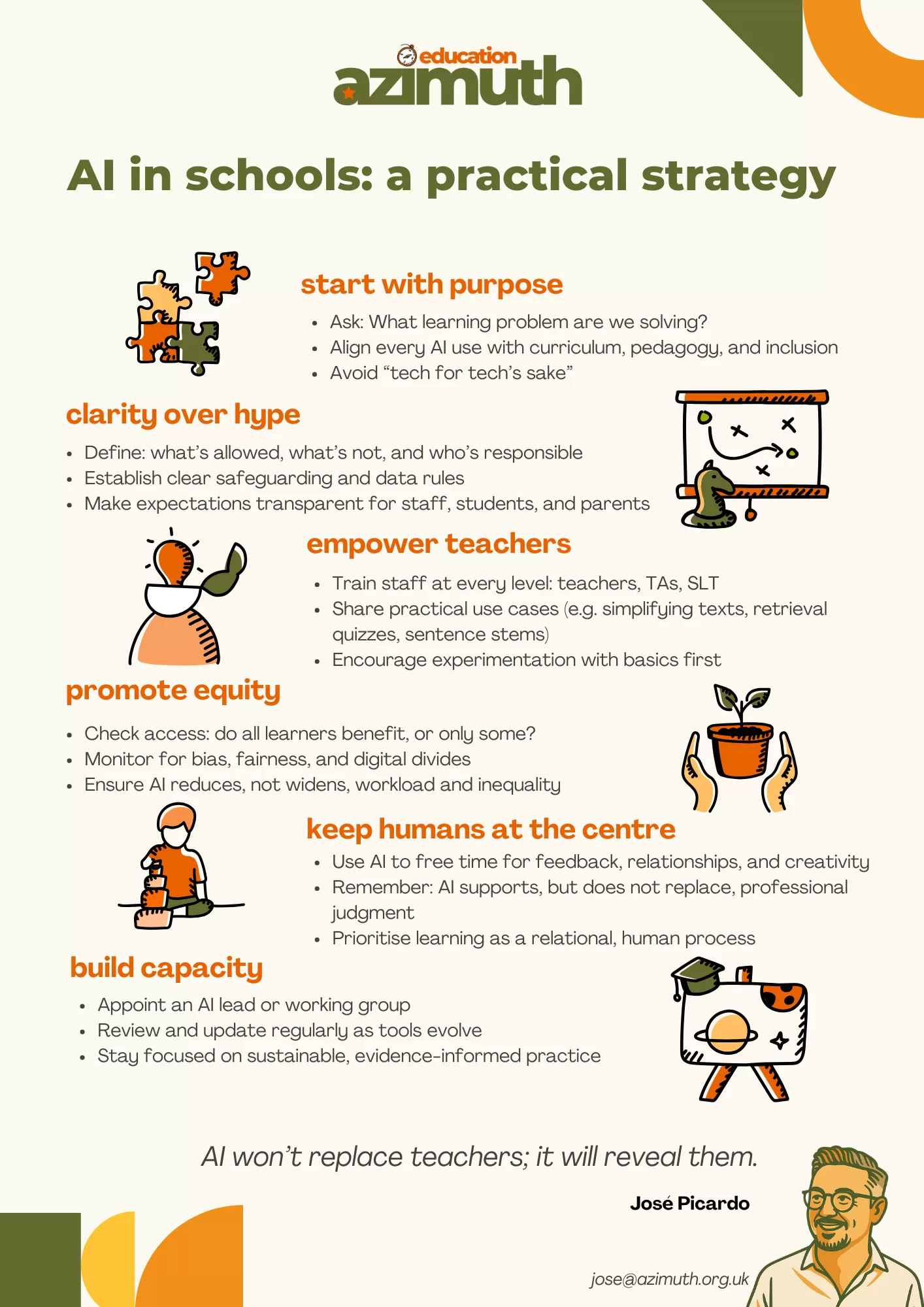Walk into any school staffroom or boardroom today and the conversation about AI will be mixed. Some colleagues may roll their eyes at the latest “game-changing” technology, already bracing themselves for another initiative to add to their workload.
Others might feel guilty that they’ve dabbled with AI, but only to produce lesson starters or maybe to gingerly experiment with adjusting reading complexity, never quite hitting the revolutionary shift they’ve been led to expect. Meanwhile, senior leaders feel the pressure of governing boards asking, “What’s our AI strategy?” without much clarity about what such a strategy should do or look like.
The world as it is
- Teachers feel both browbeaten and paralysed. AI is positioned as revolutionary, but in practice, many don’t know how to use it without risking workload, data privacy, or their pupils’ development.
- Teachers think they must use new tech to do new things: AI-generated personal learning journeys, virtual field trips, or conversations with the likes of Alexander the Great and Winston Churchill. Faced with limited planning time, these novelties feel time-consuming and their benefits vaguely articulated, so many simply opt out.
- In the shifting grounds of rapid change, leadership can lack clear policies, leaving staff uncertain. Teachers shouldn’t have to guess what’s allowed, what’s safe, or what’s worthwhile.
- Schools feel the pressure to adopt tools because they are new, not because they solve an identified problem. That leads to wasted energy and eroded trust.
The world as it could be
Imagine instead a classroom where AI is not another burden but a capable assistant. A tool that takes three minutes to simplify a complex text rather than thirty and that produces personalised retrieval quizzes so you can spend your time on crafting the questions, not on formatting multiple-choice answers.
Imagine leadership teams who start with purpose, not platforms, and who ask, “What learning challenge are we trying to solve?” before unconvincingly proclaiming the importance of adopting AI.
Picture schools where:
- Clear policies provide confidence. Teachers know what’s permissible and where the guardrails lie.
- A designated AI lead or working group keeps the school informed, trained, and safeguarded.
- Professional development ensures teachers, TAs, and SLT all understand both the risks and opportunities.
- AI augments the basics, such as comprehension questions, sentence stems, vocabulary resources, so teachers can focus on the relational, human work no AI chatbot should replace.
AI then isn’t about swapping exercise books for conversations with Florence Nightingale. AI is about rethinking what technology is for: helping us do the fundamentals more often, more effectively, and with greater equity.
AI in Schools: A Practical Strategy
At the heart of this shift is clarity. Schools need a simple, actionable framework to guide decisions and keep the focus on learning. One way of thinking about it is through six key elements:
1 Start with Purpose – What problem are we solving? Align AI with curriculum and pedagogy.
2 Clarity over Hype – Clear rules, responsibilities, and safeguarding of data.
3 Empower Teachers – Training and practical examples that enhance, not overwhelm.
4 Promote Equity – Ensure all learners benefit; monitor for gaps and bias.
5 Keep Humans at the Centre – Free teachers to do what only they can: feedback, relationships, creativity.
6 Build Capacity – Build capacity sustainably; don’t chase trends or fads.

Back and forth: pain and possibility
Left unguided, AI can further erode trust in education. Students will cut corners. Staff will improvise without oversight. Leaders will feel the need to do something, and therefore some thing will be done.
However, with thoughtful strategy, AI can reveal rather than replace teachers. The ones who adapt it with clarity of purpose will free up time and energy to focus on the irreplaceably human aspects of learning: feedback, encouragement, relationships.
Yes, if schools rush adoption, AI can potentially deepen inequality, as those students with access, skills, and support will flourish while others fall behind.
But if schools prioritise inclusion, train staff, and build in equity safeguards, AI could close gaps in access to resources, scaffolds, and personalised support.
The decision point
The choice is pressing. We can remain in the status quo: teachers overwhelmed, leaders reactive, AI reduced to hype and headaches. Or we can move toward a more purposeful, empowering vision: AI as a servant of learning, not its master.
What’s at stake if we do nothing? Another cycle of disillusionment, wasted investment, and lost trust, just as we’ve seen with countless technologies before.
What’s possible if we act? A system where AI strengthens teaching, reduces workload, and amplifies equity.
This transformation begins not with tools but with leadership, clarity, and courage.
If you’re a leader, governor, or teacher who wants to take the next step in crafting an AI strategy that is evidence-informed, humane, and sustainable, I’d love to work with you, putting learning first and using technology to serve that mission. Don’t hesitate to get in touch or leave a comment.
A PDF version of the poster illustrating this article is available from my free resources page, which you might be interested in exploring.
“Change is a process, not an event.”
— Andy Hargreaves
Photo by Karola G




One Comment